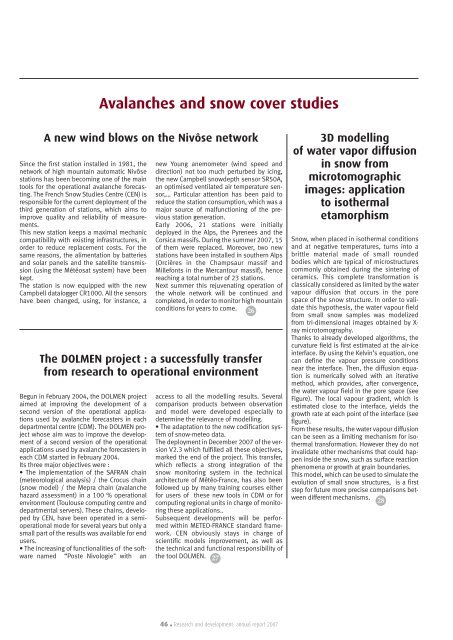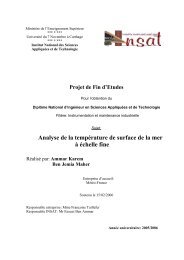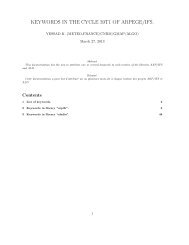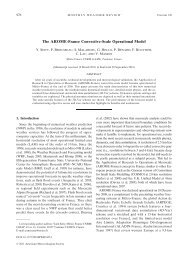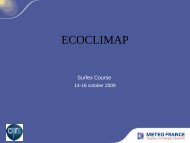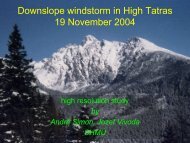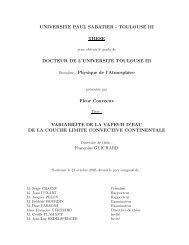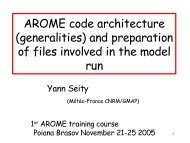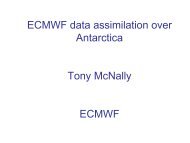3 - Centre National de Recherches Météorologiques - Météo France
3 - Centre National de Recherches Météorologiques - Météo France
3 - Centre National de Recherches Météorologiques - Météo France
Create successful ePaper yourself
Turn your PDF publications into a flip-book with our unique Google optimized e-Paper software.
Avalanches and snow cover studiesA new wind blows on the Nivôse networkSince the first station installed in 1981, thenetwork of high mountain automatic Nivôsestations has been becoming one of the maintools for the operational avalanche forecasting.The French Snow Studies <strong>Centre</strong> (CEN) isresponsible for the current <strong>de</strong>ployment of thethird generation of stations, which aims toimprove quality and reliability of measurements.This new station keeps a maximal mechaniccompatibility with existing infrastructures, inor<strong>de</strong>r to reduce replacement costs. For thesame reasons, the alimentation by batteriesand solar panels and the satellite transmission(using the Météosat system) have beenkept.The station is now equipped with the newCampbell datalogger CR1000. All the sensorshave been changed, using, for instance, anew Young anemometer (wind speed anddirection) not too much perturbed by icing,the new Campbell snow<strong>de</strong>pth sensor SR50A,an optimised ventilated air temperature sensor,…Particular attention has been paid toreduce the station consumption, which was amajor source of malfunctioning of the previousstation generation.Early 2006, 21 stations were initially<strong>de</strong>ployed in the Alps, the Pyrenees and theCorsica massifs. During the summer 2007, 15of them were replaced. Moreover, two newstations have been installed in southern Alps(Orcières in the Champsaur massif andMillefonts in the Mercantour massif), hencereaching a total number of 23 stations.Next summer this rejuvenating operation ofthe whole network will be continued andcompleted, in or<strong>de</strong>r to monitor high mountainconditions for years to come. 26The DOLMEN project : a successfully transferfrom research to operational environmentBegun in February 2004, the DOLMEN projectaimed at improving the <strong>de</strong>velopment of asecond version of the operational applicationsused by avalanche forecasters in each<strong>de</strong>partmental centre (CDM). The DOLMEN projectwhose aim was to improve the <strong>de</strong>velopmentof a second version of the operationalapplications used by avalanche forecasters ineach CDM started in February 2004.Its three major objectives were :• The implementation of the SAFRAN chain(meteorological analysis) / the Crocus chain(snow mo<strong>de</strong>l) / the Mepra chain (avalanchehazard assessment) in a 100 % operationalenvironment (Toulouse computing centre and<strong>de</strong>partmental servers). These chains, <strong>de</strong>velopedby CEN, have been operated in a semioperationalmo<strong>de</strong> for several years but only asmall part of the results was available for endusers.• The increasing of functionalities of the softwarenamed “Poste Nivologie" with anaccess to all the mo<strong>de</strong>lling results. Severalcomparison products between observationand mo<strong>de</strong>l were <strong>de</strong>veloped especially to<strong>de</strong>termine the relevance of mo<strong>de</strong>lling.• The adaptation to the new codification systemof snow-meteo data.The <strong>de</strong>ployment in December 2007 of the versionV2.3 which fulfilled all these objectives,marked the end of the project. This transfer,which reflects a strong integration of thesnow monitoring system in the technicalarchitecture of Météo-<strong>France</strong>, has also beenfollowed up by many training courses eitherfor users of these new tools in CDM or forcomputing regional units in charge of monitoringthese applications..Subsequent <strong>de</strong>velopments will be performedwithin METEO-FRANCE standard framework.CEN obviously stays in charge ofscientific mo<strong>de</strong>ls improvement, as well asthe technical and functional responsibility ofthe tool DOLMEN. 273D mo<strong>de</strong>llingof water vapor diffusionin snow frommicrotomographicimages: applicationto isothermaletamorphismSnow, when placed in isothermal conditionsand at negative temperatures, turns into abrittle material ma<strong>de</strong> of small roun<strong>de</strong>dbodies which are typical of microstructurescommonly obtained during the sintering ofceramics. This complete transformation isclassically consi<strong>de</strong>red as limited by the watervapour diffusion that occurs in the porespace of the snow structure. In or<strong>de</strong>r to validatethis hypothesis, the water vapour fieldfrom small snow samples was mo<strong>de</strong>lizedfrom tri-dimensional images obtained by X-ray microtomography.Thanks to already <strong>de</strong>veloped algorithms, thecurvature field is first estimated at the air-iceinterface. By using the Kelvin’s equation, onecan <strong>de</strong>fine the vapour pressure conditionsnear the interface. Then, the diffusion equationis numerically solved with an iterativemethod, which provi<strong>de</strong>s, after convergence,the water vapour field in the pore space (seeFigure). The local vapour gradient, which isestimated close to the interface, yields thegrowth rate at each point of the interface (seefigure).From these results, the water vapour diffusioncan be seen as a limiting mechanism for isothermaltransformation. However they do notinvalidate other mechanisms that could happeninsi<strong>de</strong> the snow, such as surface reactionphenomena or growth at grain boundaries.This mo<strong>de</strong>l, which can be used to simulate theevolution of small snow structures, is a firststep for future more precise comparisons betweendifferent mechanisms.2846 . Research and <strong>de</strong>velopment: annual report 2007


